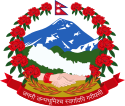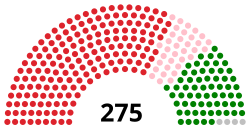Federal Parliament of Nepal
Federal Parliament of Nepal संघीय संसद, नेपाल | |
|---|---|
 | |
| Type | |
| Type | |
| Houses | National Assembly (upper house) House of Representatives (lower house) |
| History | |
| Founded | 5 March 2018 |
| Preceded by | Constituent Assembly of Nepal |
| Leadership | |
Nanda Kishor Pun since 31 October 2015 | |
Chairman of the National Assembly | Ganesh Prasad Timilsina since 15 March 2018 |
Deputy Chairman of the National Assembly | Shashikala Dahal since 19 March 2018 |
Speaker of the House of Representatives | |
Deputy Speaker of the House of Representatives | vacant since 20 January 2020 |
| Structure | |
| Seats | 334 59 assemblymen 275 representatives |
 | |
House of Representatives political groups | Government (174)
Opposition (101)
|
 | |
National Assembly political groups | Government (50)
Opposition (9) |
| House of Representatives committees | 10 |
| National Assembly committees | 4 |
Joint committees | 2 |
| Elections | |
| First-past-the-post & proportional representation | |
| Single transferable vote | |
House of Representatives last election | 26 November and 7 December 2017 |
National Assembly last election | 23 January 2020 |
| Meeting place | |
 | |
| International Convention Centre, Kathmandu, Nepal | |
| Website | |
| www | |
| Constitution | |
| Constitution of Nepal | |
| File:New Emblem of Nepal.svg |
|---|
| This article is part of a series on the politics and government of Nepal |
|
Executive:
Judiciary: |
|
Related topics |
The Federal Parliament of Nepal (संघीय संसद नेपाल, Saṅghīya Sansada Nēpāla) is the bicameral federal and supreme legislature of Nepal established in 2018. It consists of the National Assembly as the upper house and the House of Representatives as the lower house.
History[edit]
Legislatures of Kingdom of Nepal[edit]
The former Parliament of Nepal was dissolved by King Gyanendra in 2002, on the grounds that it was incapable of handling the Maoist rebels. The country's five main political parties had staged protests against the king, arguing that he must either call fresh elections or reinstate the elected legislature. In 2004, the king announced that parliamentary elections would be held within twelve months; in April 2006, in response to major pro-democratic protests, it was announced that Parliament would be reestablished.[2]
Interim Legislature of Nepal[edit]
After the success of the April 2006 people's movement, on January 15, 2007, the old parliament was dissolved and replaced by a 330-member interim legislature of Nepal.[citation needed] The legislature drafted an interim constitution and a constituent assembly election was held in April 2008. The 601-member assembly on 28 May 2008 abolished the 238-year-old monarchy and declared the country a republic. The constituent assembly, which was initially given two years to draft a new constitution, was dissolved on 27 May 2012 after its failure to draft a new constitution due to differences over restructuring the state.
Legislature Parliament of Nepal[edit]
The second Nepalese Constituent Assembly was converted into a legislative parliament of Nepal after the promulgation of the constitution on September 20, 2015.[3] The second Nepalese Constituent Assembly was formed after the failure of the first Constituent Assembly to draft a new constitution. The Legislature Parliament of Nepal was dissolved on 21 January 2018 (7 Magh, 2074 BS).[4]
Composition[edit]
According to the Constitution of Nepal 2015, Nepal has a two-chamber Parliament (संसद), consisting of the House of Representatives and the National Assembly, with the President of Nepal acting as their head.[5]
President of Nepal[edit]
The President of the Federal Democratic Republic of Nepal (नेपालको राष्ट्रपति, Nēpālakō rāṣṭrapati) is the head of state of Nepal and commander in chief of the Nepalese Armed Forces and the supreme leader of the country. The office was created in May 2008 after the country was declared as a republic. The first President of Nepal was Ram Baran Yadav. The current president is Bidhya Devi Bhandari, elected in October 2015. She is the first female Nepali head of state. The President is to be formally addressed as "The Right Honourable" (सम्माननीय, Sam'mānanīya).[6]
House of Representatives[edit]
The House of Representatives (प्रतिनिधि सभा, Pratinidhi Sabha) has 275 members. 165 members are elected from single-member constituencies by first-past-the-post voting and 110 elected through proportional electoral system where voters vote for political parties, considering the whole country as a single election constituency. The members of the house hold their seats for five years or until the body is dissolved by the President on the advice of the council of ministers.
National Assembly[edit]
The National Assembly (राष्ट्रिय सभा, Rastriya Sabha) has 59 members. Eight members are elected from each of the seven provinces by an electoral college of each province, and three are appointed by the President on recommendation of the government. They must include at least three women, one Dalit, and one member from disabled groups. Members serve staggered six year terms such that the term of one-third members expires every two years.
Parliamentary committees[edit]
There are 16 thematic committees in the federal parliament: ten in the House of Representatives, four in the National Assembly and two common.[7]
House of Representatives[edit]
- Finance
- International Relations
- Industry, Commerce, Labour and Consumer Interest
- Law, Justice, and Human Rights
- Agriculture, Cooperative and Natural Resources
- Women and Social
- State Affairs
- Development and Technology
- Education and Health
- Public Account
National Assembly[edit]
- Sustainable Development and Good Governance
- Legislative Management
- Delegated Legislation and Government Assurances
- National Interest and coordination among members
Both[edit]
- Parliamentary Hearing
- State Direction, Principle Rules and Responsibility
Women's Representation[edit]
The constitution of Nepal guarantees a 33% reservation for women in all public offices including the federal pariament. On 16 March 2018, Dr. Shiva Maya Tumbahamphe was elected as the deputy speaker of the house.[8] Women’s representation in the parliament has increased since the Constituent Assembly, which eventually guaranteed provisions for women's representation on the constitution.[2]
Parliament House[edit]
Both houses of the federal parliament currently meet at the International Convention Centre in New Baneshwor, Kathmandu. A new parliament building is being constructed in the premises of the Singha Durbar complex, which houses most government offices.[9]
See also[edit]
References[edit]
- ↑ "Elected Speaker". Nepal Republic Media. Kathmandu, Nepal. 26 January 2020. Archived from the original on 16 March 2018. Retrieved 15 March 2018. Unknown parameter
|url-status=ignored (help) - ↑ 2.0 2.1 "Nepal's Political Development: Nepal Constituent Assembly Portal". Nepalcaportal.org. Archived from the original on 3 August 2010. Retrieved 10 April 2010. Unknown parameter
|url-status=ignored (help) - ↑ "Nepal elects first woman speaker of parliament - Times of India".
- ↑ "संविधानसभा प्रथम". parliament.gov.np. Archived from the original on 13 December 2017. Retrieved 13 December 2017. Unknown parameter
|url-status=ignored (help) - ↑ "Archived copy" (PDF). Archived from the original (PDF) on 23 December 2015. Retrieved 8 December 2015. Unknown parameter
|url-status=ignored (help)CS1 maint: Archived copy as title (link) - ↑ "President of Nepal", Wikipedia, 2019-12-29, retrieved 2020-01-19
- ↑ "All parliamentary committees in place". The Kathmandu Post. Retrieved 2020-06-14. Unknown parameter
|url-status=ignored (help) - ↑ "CPN-UML leader Tumbahamphe elected to Deputy Speaker of HoR". 16 March 2018.
- ↑ "New building for federal parliament to cost Rs5 billion rupees". The Kathmandu Post. Retrieved 2020-06-14. Unknown parameter
|url-status=ignored (help)

